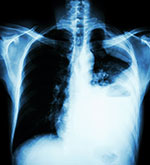At a glance
- Asbestos is a dangerous substance and should be avoided.
- People who have contact with asbestos are at risk of developing health problems.
- Learn more about the dangerous health effects asbestos can cause.

Overview
Disturbing asbestos minerals or other asbestos-containing materials can release tiny asbestos fibers, too small to see, into the air. Breathing asbestos can cause tiny asbestos fibers to get stuck in the lungs and irritate lung tissues.
Workers and others who breathed asbestos fibers over many years have developed asbestos-related cancer and noncancer diseases.
Some of these diseases can be serious or even fatal.
Cancer
Asbestos exposure also increases the risk of developing certain cancers.
Lung cancer is a malignant tumor that invades and blocks the lung's air passages. Smoking tobacco combined with asbestos exposure greatly increases the chance of developing lung cancer.
Mesothelioma is a rare cancer of the membrane lining the lungs and chest cavity, abdominal cavity, or other organs. Signs of mesothelioma may not appear until 30 to 40 years after exposure to asbestos.
In addition to lung cancer and mesothelioma, asbestos exposure can also cause cancer of the larynx and ovary. Current evidence also suggests asbestos exposure may cause cancer of the pharynx, stomach, and colorectum.
Noncancer diseases
Scientific studies have shown that the noncancer diseases asbestosis and pleural disease can be caused by breathing in asbestos.
Asbestosis is scarring in the lungs caused by breathing asbestos fibers. Oxygen and carbon dioxide do not pass in and out of scarred lungs easily. This causes breathing to become harder. Asbestosis usually occurs from very high exposures over a long time.
Pleural disease is a lung condition that causes changes in the membrane surrounding the lungs and chest cavity. The membrane may become thicker throughout or in isolated areas. Fluid may also build up around the lungs.

